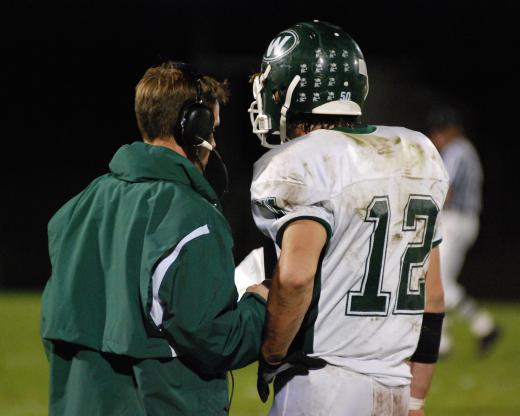The 3-4 and 4-3 are the two most common defensive schemes in football. In the NFL in particular, there have been revolving trends toward one or the other, but both are well established as base defenses. The numbers represent the number of defensive linemen and linebackers in the scheme, respectively.
The 4-3 is considered the more classic style of defense. It uses four defensive linemen and three linebackers. The 3-4 defense uses just three defensive linemen and four linebackers.

In the 4-3, the responsibility for creating pressure on the quarterback generally comes from the defensive line — specifically the defensive ends — although the linebackers will blitz occasionally. The linebackers in this style are mainly required to stop the run and drop into pass coverage. The roles change in the 3-4 defense. The defensive linemen are more responsible for taking on multiple blockers and opening holes for the linebackers to attack through. The linebackers rush the quarterback much more often, especially the outside linebackers.

The differences between the schemes call for different types of players at certain key positions. The defensive tackles — the interior linemen — in a 4-3 must be big enough to take on multiple blockers and to stop the run, but not so big that they cannot slide through the line and get to the quarterback on occasion. The nose tackle in a 3-4 must be even bigger, as he is responsible for plugging up the middle all by himself and has very little pass rushing responsibility.

The defensive ends in a 4-3 defense should be big enough to take on an offensive tackle one-on-one, but athletic enough to get around the tackle and get to the quarterback. The defensive ends in a 3-4, however, are similar in size and responsibility to the defensive tackles in the 4-3. They must be stout against the run and should take on multiple blockers to help out the linebackers. Pass rushing from a 3-4 defensive end is something of a bonus.

The outside linebackers in a 4-3 can get away with being a little undersized because their primary responsibility is stopping the run and dropping into coverage. The outside linebackers in a 3-4, on the other hand, are the playmakers. They are often referred to as "tweeners" because their size and athleticism fall somewhere between that of the outside linebacker and the defensive end in a 4-3 defense. The 3-4 outside linebackers are primarily pass rushers, so they must be big enough to take on the tackle, but athletic and nimble enough to drop into pass coverage, as well.
While it is usually more difficult to find the personnel for a 3-4 defense — since it requires a mammoth presence inside at nose tackle and exceptional athletes at outside linebacker — it is often preferred by defensive coaches who like the flexibility and unpredictability it creates in rushing the passer. It is never certain which linebackers will be rushing the quarterback and which will be dropping into coverage. The 4-3 is more versatile in terms of utilizing the strengths and characteristics of a group of players, and therefore the more common of the two.
